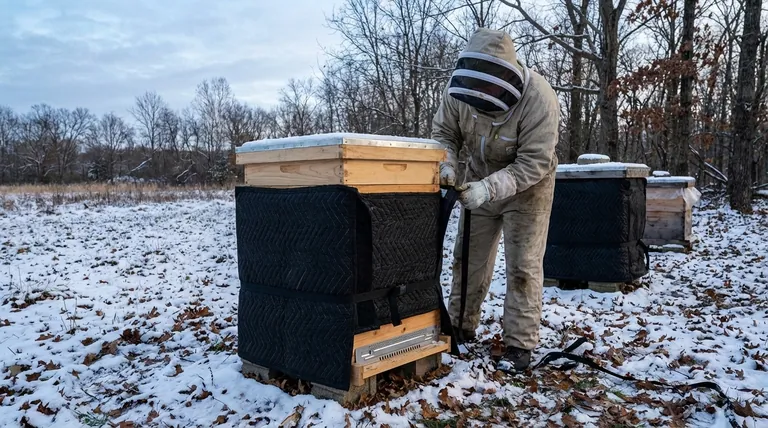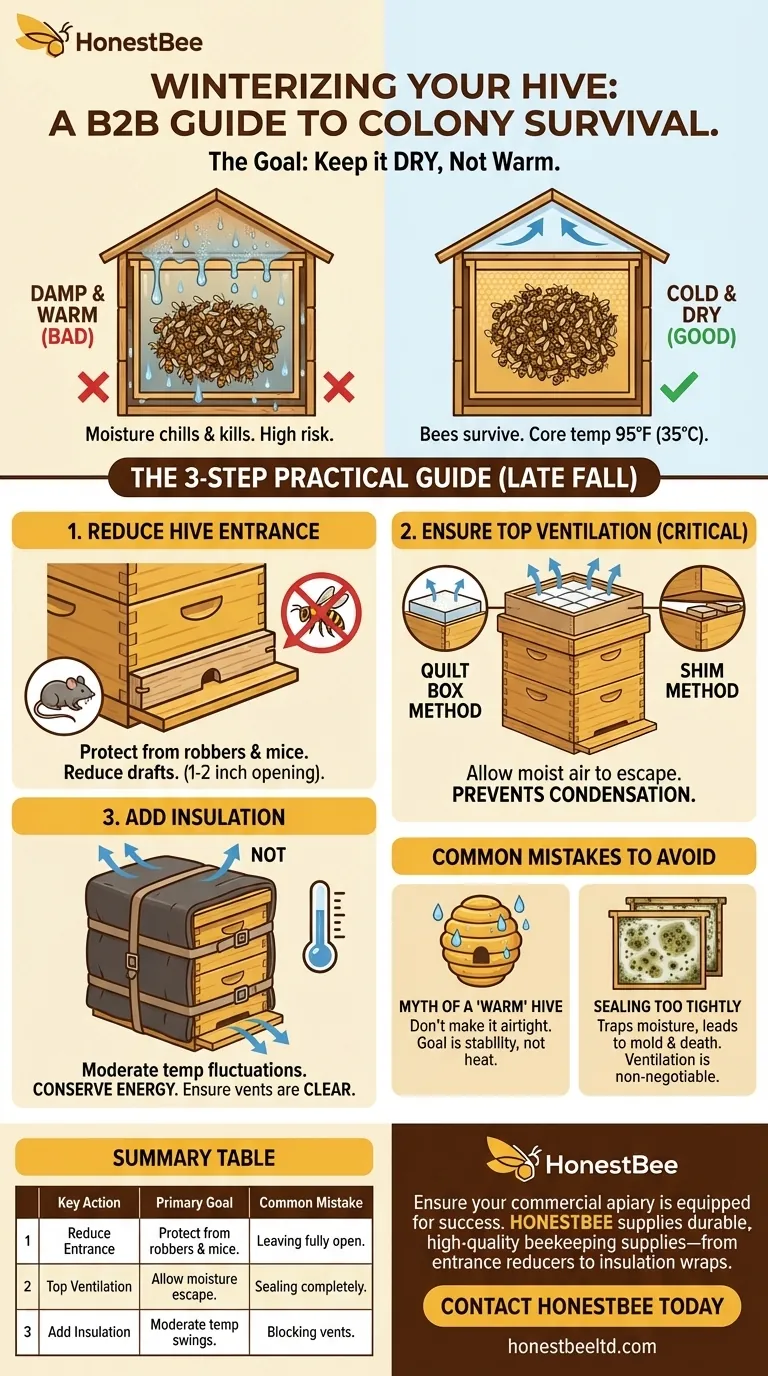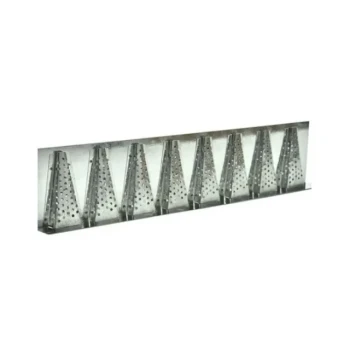To properly winterize a beehive, you must reduce the hive entrance, manage internal moisture, and add insulation. These actions protect the colony from robbers and mice, prevent condensation from chilling the cluster, and help the bees maintain a stable temperature without expending excess energy.
The primary goal of winterizing is not to keep the hive warm, but to keep it dry. A cold but dry colony can survive, whereas a damp colony, even in milder temperatures, is at high risk of perishing.

The Core Principles of Colony Survival
Winter presents three primary threats to a honey bee colony: starvation, moisture, and extreme temperature swings. Your winterizing strategy must address all three, but moisture is the most insidious enemy.
Why Moisture is the Real Killer
As bees consume honey, they generate metabolic heat, water vapor, and carbon dioxide. In a poorly ventilated hive, this warm, moist air rises, hits the cold inner cover, and condenses. This cold water then drips back down onto the winter cluster, chilling the bees and potentially killing the colony.
The Goal of Insulation
Insulation doesn't heat the hive; it moderates temperature fluctuations. A well-insulated hive helps the bees maintain the core temperature of their cluster (around 95°F / 35°C) more efficiently. This means they consume less honey, reducing the risk of starvation and the amount of moisture they produce.
A Practical Winterization Guide
The best time to perform these actions is in late fall, before your region's first hard frost but after the bees' activity has noticeably slowed.
Step 1: Reduce the Hive Entrance
A large, open entrance is a liability in winter. You must reduce it to a small opening, typically 1-2 inches wide.
This simple action protects the colony from robbing by other bees, prevents mice from nesting inside the warm hive, and reduces cold drafts that can disrupt the cluster.
Step 2: Ensure Top Ventilation for Moisture Control
This is the most critical step. You must give the moisture generated by the bees an escape route at the top of the hive.
One effective method is to use a quilt box. This is a shallow box filled with absorbent material like burlap or wood shavings, placed on top of the uppermost hive body. It absorbs moisture while allowing air to circulate.
A simpler method is to create a small ventilation gap. Place popsicle sticks or a small shim under the corners of the inner cover to create a slight crack, allowing moist air to escape.
Step 3: Add Insulation or a Hive Wrap
Once ventilation is handled, you can add insulation. This typically involves wrapping the hive bodies with rigid foam insulation board or a commercial hive wrap.
Secure the insulation firmly with heavy-duty tape, straps, or staples so it can withstand winter winds. Crucially, ensure the wrap does not block the hive entrance or any ventilation openings you created.
Step 4: Final Checks
Before closing up the hive for the season, ensure the bees have an adequate food supply (a full, heavy hive). Wear your protective gear, as bees can be more defensive when their hive is being disturbed in the fall.
Understanding the Trade-offs: Common Mistakes to Avoid
Success lies in understanding the principles, not just following steps. Many new beekeepers make critical errors by misunderstanding the goal.
The Myth of a "Warm" Hive
Do not try to make your hive airtight and warm. Honey bees are remarkably cold-hardy and can survive deep freezes as long as they are dry and have food. Your goal is stability, not heat.
The Danger of Sealing Too Tightly
The single biggest mistake is sealing a hive completely. This traps moisture, leading to moldy frames, stressed bees, and a high likelihood of colony death. Ventilation is non-negotiable.
Forgetting to Monitor
Winterizing is not a one-time event. Periodically check the hive entrance on milder days to ensure it is not blocked by dead bees, which can impede cleansing flights. After a storm, check that wraps and covers are still secure.
Making the Right Choice for Your Goal
Your specific approach should be tailored to your climate and goals.
- If your primary focus is surviving a cold, wet climate: Prioritize superior moisture control by using a quilt box over simpler ventilation methods.
- If your primary focus is surviving a cold, dry, and windy climate: Emphasize a solid windbreak and securely fastened insulation to minimize heat loss from convection.
- If you are a new beekeeper and want the simplest effective method: Focus on the essentials: an entrance reducer and a small shim under the inner cover for ventilation.
Proper winterization empowers your colony to use its own remarkable survival instincts to make it through to spring.
Summary Table:
| Key Action | Primary Goal | Common Mistake to Avoid |
|---|---|---|
| Reduce Hive Entrance | Protect from robbers and mice; reduce drafts. | Leaving the entrance fully open. |
| Ensure Top Ventilation | Allow moisture to escape; prevent condensation. | Sealing the hive completely (traps moisture). |
| Add Insulation/Wrap | Moderate temperature swings; conserve bee energy. | Blocking the entrance or ventilation with the wrap. |
| Final Food & Security Check | Ensure adequate food supply; secure hive components. | Disturbing the hive without protective gear. |
Ensure your commercial apiary or distribution business is equipped for success. Proper winterization is critical for colony health and honey production. HONESTBEE supplies the durable, high-quality beekeeping supplies and equipment—from entrance reducers and insulation wraps to full hive components—that commercial beekeepers and distributors trust. Let us help you build a more resilient operation.
Contact HONESTBEE today to discuss your wholesale needs and prepare your hives for a thriving spring.
Visual Guide

Related Products
- Beehive Entrance Reducer Guardian Metal Hive Entrance for Bees
- Multi-Functional Sliding Hive Entrance for Beekeeping
- Multi-Functional Rotary Hive Entrance Disc for Beekeeping
- Steel Round Disc Entrance Reducer for Flexzion Bee Hive Nuc Box Gate
- Professional Ant-Proof Beehive Stand with Integrated Moat for Beekeeping
People Also Ask
- How big should a beehive entrance be? Optimize for Colony Health & Honey Production
- What should be done after transferring frames to the new hive? Essential Steps for a Secure Colony
- What are the different entrance sizes for an 8 or 10-frame Langstroth hive? A Guide to Seasonal Management
- What happens if you seal an entrance to a bee hive? Avoid a Costly Structural Disaster
- How can a Langstroth hive entrance be adjusted? Mimic Natural Bee Preferences for a Healthier Hive



















